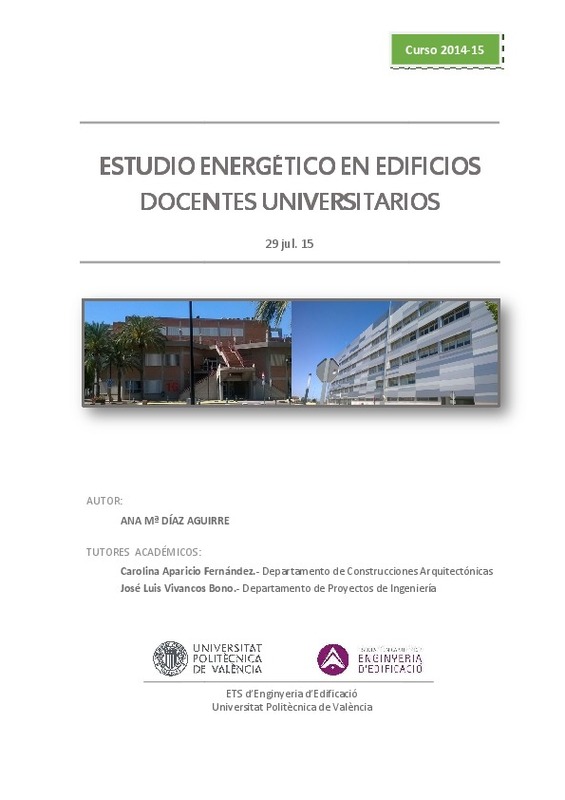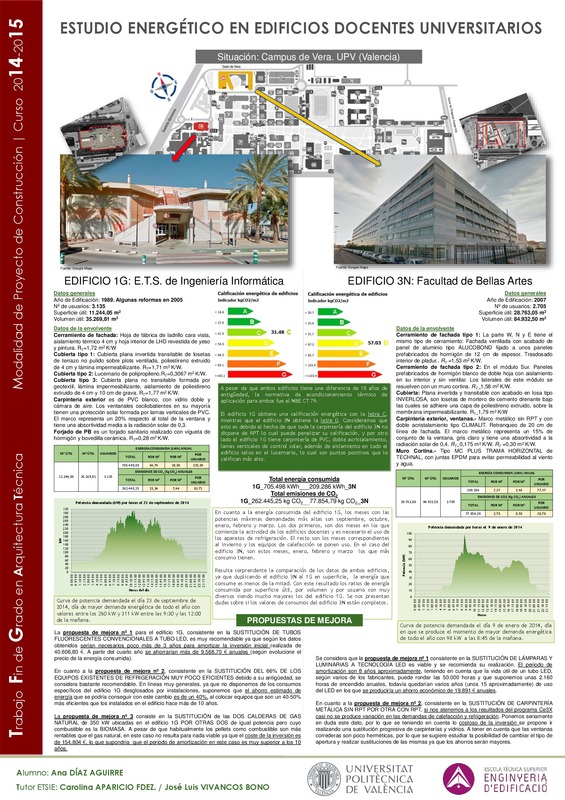|
[ES] Con este estudio se pretende analizar el comportamiento energético de dos edificios situados en el campus de la Universidad Politécnica de Valencia. Los edificios seleccionados son la Escuela Técnica Superior de ...[+]
[ES] Con este estudio se pretende analizar el comportamiento energético de dos edificios situados en el campus de la Universidad Politécnica de Valencia. Los edificios seleccionados son la Escuela Técnica Superior de Ingeniería Informática y la Facultad de Bellas Artes. En primer lugar se hará una descripción de las características de cada uno de ellos acompañada de un análisis de sus consumos energéticos y de la certificación energética del edificio. Se obtendrán los ratios de energía consumida por superficie útil, por volumen del edificio y por usuario. Todos estos datos tendrán asociadas sus correspondientes emisiones de CO2. Una vez analizado cada edificio, se procederá a comparar los resultados de ambos entre sí. Se pretende así evaluar las diferencias en consumos de energía que se pueden dar entre edificios de diferentes épocas, diferentes dimensiones, tipologías constructivas o incluso usos, y sacar conclusiones al respecto. Las conclusiones de este estudio se podrían utilizar para mejorar la eficiencia energética de las instalaciones de la Universidad Politécnica, obteniendo así un considerable ahorro de energía, un mayor confort de sus usuarios, un ahorro económico en las facturas y una indudable contribución al medio ambiente reduciendo las emisiones de CO2.
[-]
[EN] This study will analyse the energy performance of two buildings located at the Polytechnic University of Valencia. The selected buildings are the "Higher Technical School of Computer Engineering" and the "Faculty of ...[+]
[EN] This study will analyse the energy performance of two buildings located at the Polytechnic University of Valencia. The selected buildings are the "Higher Technical School of Computer Engineering" and the "Faculty of Fine Arts". This project will begin with a description of the characteristics of each building along with an analysis of their energy consumption and the energy certification of the building. The result will be the ratios of energy consumed by surface area, by building volume and by user. All of this data is associated with the corresponding CO2 emissions. Once each building has been analyzed there will be a comparison between the two buildings. The aim is to compare the differences in energy consumption in buildings of varying ages, dimensions, constructive typologies and even uses. Conclusions drawn from these comparisons can be used to improve the energy efficiency of the Polytechnic University facilities and therefore to save a considerable amount of energy, provide greater comfort for its users, savings on energy bills and a significant contribution to the environment by reducing CO2 emissions.
[-]
|











